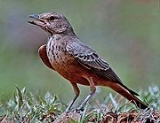
Rufous-tailed Lark
Encyclopedia
The Rufous-tailed Lark (Ammomanes phoenicura) also sometimes called the Rufous-tailed Finch-Lark is a ground bird found in the drier open stony habitats of India and parts of Pakistan. Like other species in the genus it has a large finch-like bill with a slightly curved edge to the upper mandible. The dull brown colour matches with soil as it forages for grass seeds, grain and insects. Males and females are indistinguishable in the field but during the breeding season, the male has a courtship display that involves flying up steeply and then nose-diving and pulling up in a series of stepped wavy dips accompanied by calling. They forage on the ground in pairs or small groups.
_in_kawal_ws,_ap_w_img_2009.jpg) Like other Ammomanes
Like other Ammomanes
larks the species has a wide curved beak with the nostrils covered by feathers. The hindclaw is as long as the hindtoe and moderately curved. The base of the lower mandible is fleshy while the rest is horn-grey. The legs are also flesh coloured. Some taxonomists in the past included the Bar-tailed Lark
as a subspecies but the two are now generally considered as separate species. Walter Koelz designated the peninsular Indian population south of a line between Hubli-Bellary-Ellore as a separate subspecies testaceus (=testacea) that is brighter rufous, however specimens vary in the brightness (the reddest individuals being from Mysore and Salem) leading some later workers to treat the species as monotypic. In the field, the rufous colour, the reddish rump and a dark tail band (narrowing towards the sides to give a triangular shape) are distinctive. The throat is lightly streaked in dark brown. Young birds have less streaking on the underside.
_in_kawal_ws,_ap_w_img_1985.jpg) The species is found mainly in low altitude dry regions in open habitats without significant tree cover. It is a resident mainly within India south of the Ganges extending west to Kutch and the Aravallis of Rajasthan. They are summer visitors to parts of Pakistan in northern Punjab and in southern Nepal. The species does not occur in Sri Lanka and reports of their occurrence on the island of Rameshwaram are not confirmed while the species is largely absent along the Western Ghats region particularly in Kerala.
The species is found mainly in low altitude dry regions in open habitats without significant tree cover. It is a resident mainly within India south of the Ganges extending west to Kutch and the Aravallis of Rajasthan. They are summer visitors to parts of Pakistan in northern Punjab and in southern Nepal. The species does not occur in Sri Lanka and reports of their occurrence on the island of Rameshwaram are not confirmed while the species is largely absent along the Western Ghats region particularly in Kerala.
Description
_in_kawal_ws,_ap_w_img_2009.jpg)
Ammomanes
Ammomanes is a genus of lark in the Alaudidae family.It contains the following species:* Bar-tailed Lark * Rufous-tailed Lark * Desert Lark * Gray's Lark...
larks the species has a wide curved beak with the nostrils covered by feathers. The hindclaw is as long as the hindtoe and moderately curved. The base of the lower mandible is fleshy while the rest is horn-grey. The legs are also flesh coloured. Some taxonomists in the past included the Bar-tailed Lark
Bar-tailed Lark
The Bar-tailed Lark is a species of lark in the Alaudidae family.It is found in Afghanistan, Algeria, Cape Verde, Chad, Egypt, Iran, Iraq, Israel and Palestine, Italy, Jordan, Kuwait, Lebanon, Libya, Mali, Malta, Mauritania, Morocco, Niger, Oman, Pakistan, Saudi Arabia, Sudan, Syria, Tunisia,and...
as a subspecies but the two are now generally considered as separate species. Walter Koelz designated the peninsular Indian population south of a line between Hubli-Bellary-Ellore as a separate subspecies testaceus (=testacea) that is brighter rufous, however specimens vary in the brightness (the reddest individuals being from Mysore and Salem) leading some later workers to treat the species as monotypic. In the field, the rufous colour, the reddish rump and a dark tail band (narrowing towards the sides to give a triangular shape) are distinctive. The throat is lightly streaked in dark brown. Young birds have less streaking on the underside.
Distribution
_in_kawal_ws,_ap_w_img_1985.jpg)

